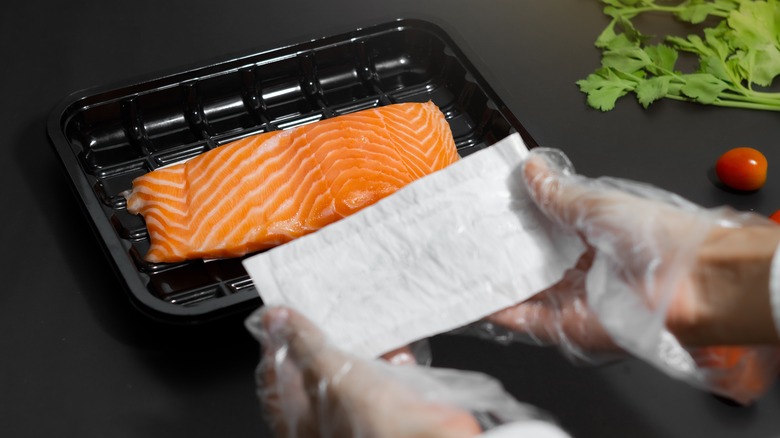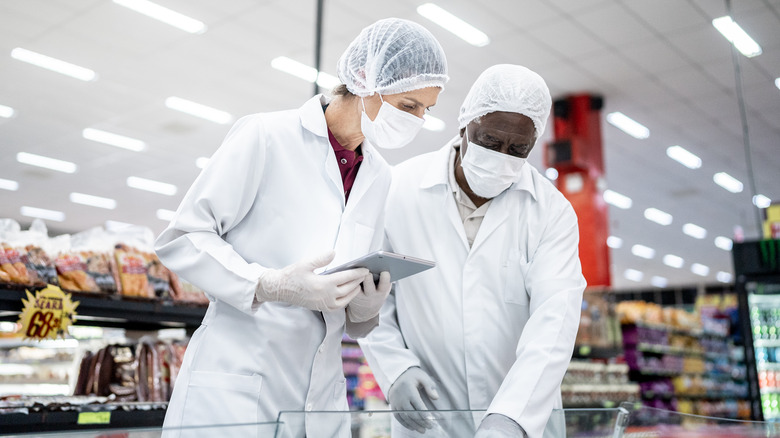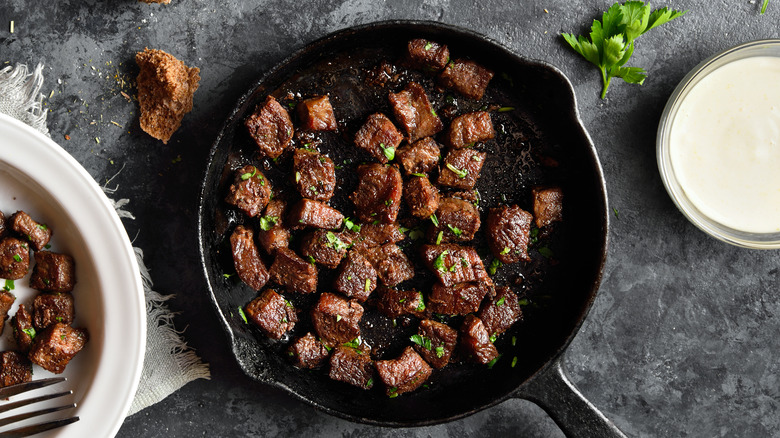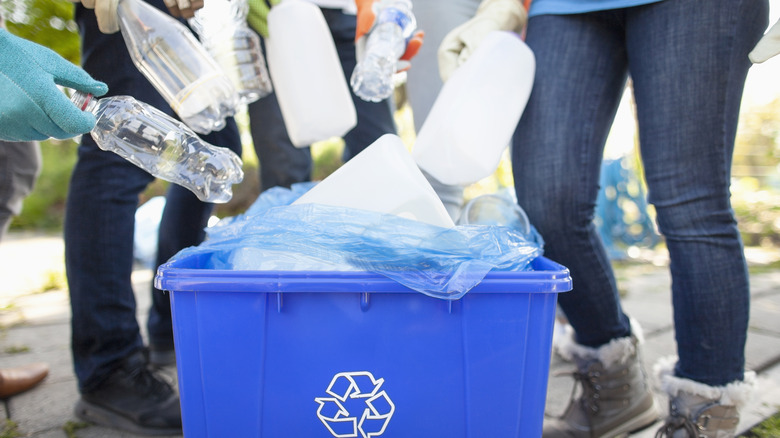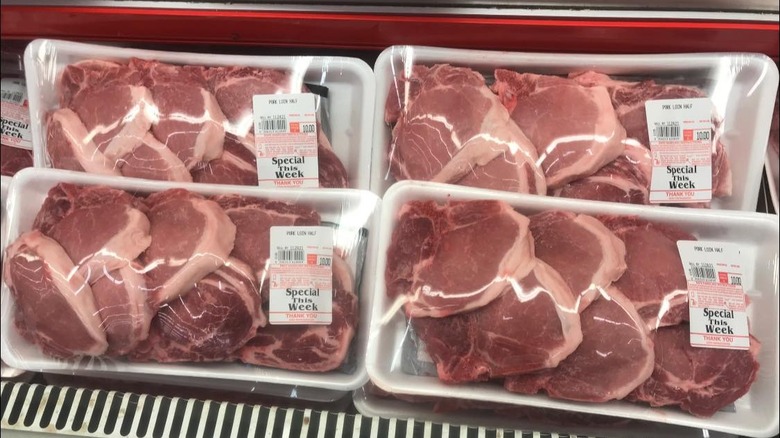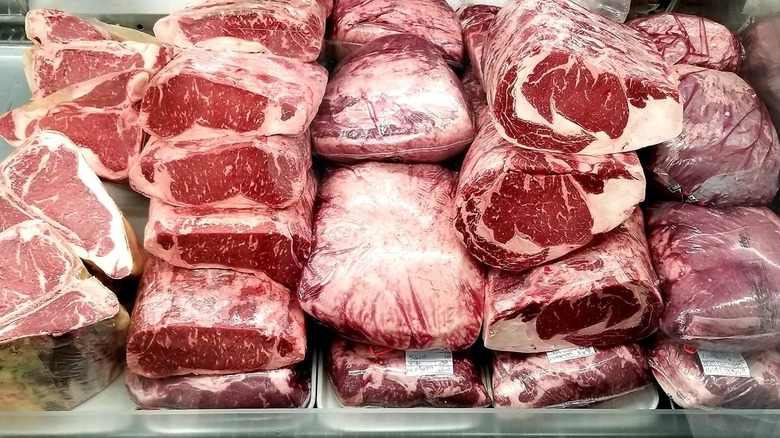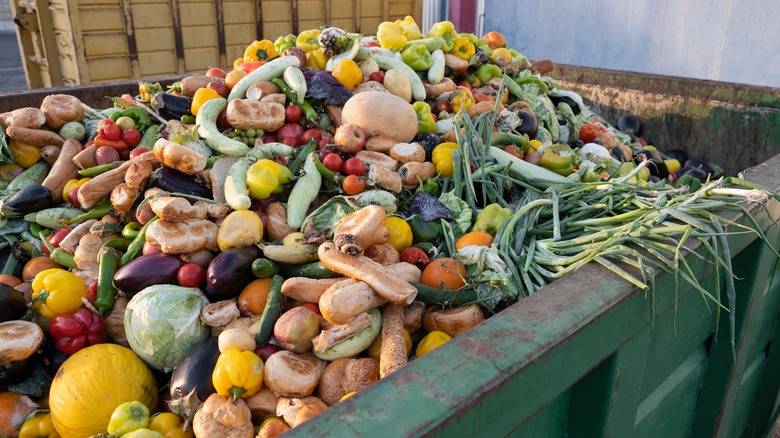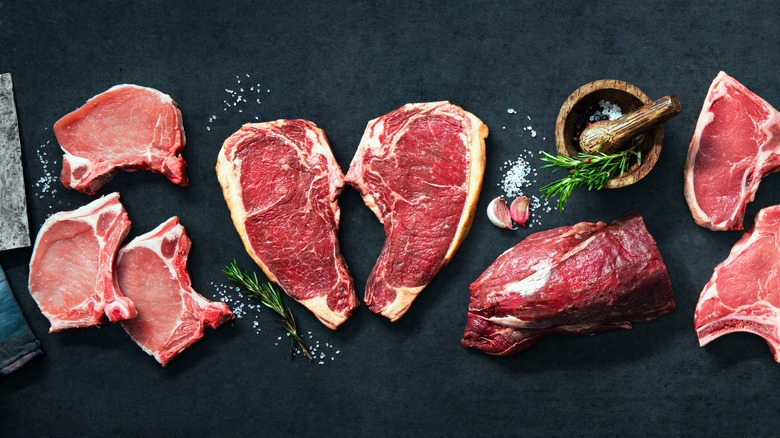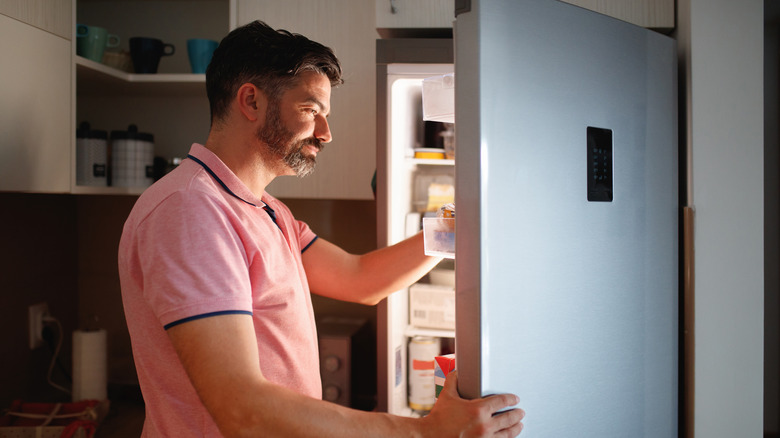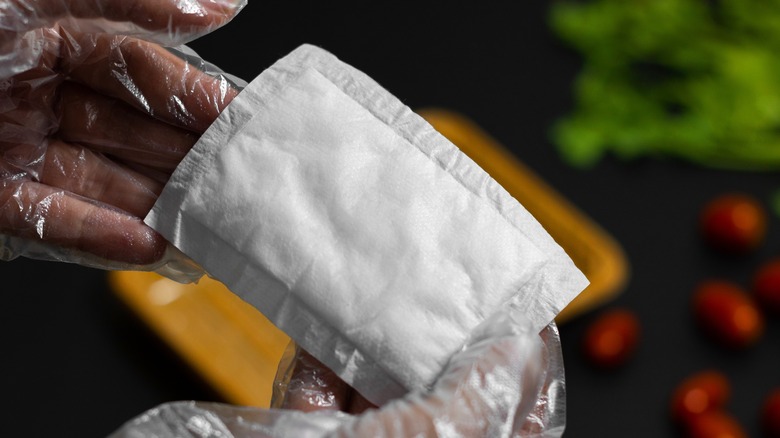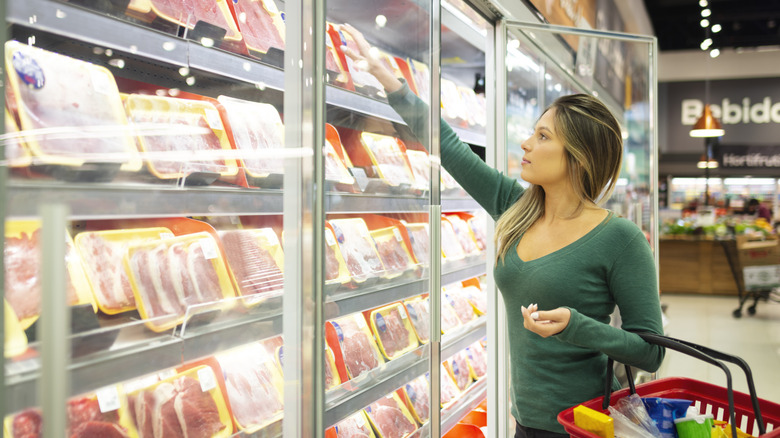Everything You Need To Know About Absorbent Meat Pads
They're slimy, they're stained, and they're a little bit gross. If you're like us, you've probably once or twice torn the plastic wrap off a slab of freshly-purchased steak or a prized fillet of salmon and wondered what's going on with this extra bit of packaging. What's the story with that weird strip of soggy plastic clinging to the bottom of your ribeye steak or Chinook salmon filet?
Found underneath the majority of wrapped, packaged meats in the U.S. and many other nations, these porous add-ins are commonly known in the industry as absorbent meat pads. As unsightly as they may be once they have been more or less doused in myoglobin and other meat juices, it turns out that these little sheets play a vital role in the meat and poultry industry. That's because there's quite a bit more to these absorptive little slips than meets the eye.
Curious? We're here to help get you up to speed and ready to drop some knowledge the next time you unwrap some succulent chicken thighs or a package of ground beef. Here's everything you need to know about absorbent meat pads.
They're not toxic
If you go to a search engine and begin typing the question, "Are absorbent meat pads...", the very first auto-fill ending to pop up may well read: "...toxic." Contrary to popular belief, however, the pads placed in the bottom of the styrofoam trays are completely innocuous, though you don't want to go munching on them any time soon. Because they will be placed in the packaging in direct contact with food, the U.S. Department of Agriculture views these pads as a type of food additive and therefore takes what goes into them very seriously.
So what does go into absorbent meat pads? The entirety of a meat pad's absorbent layer is made up of one of two things: silica gel — like the little packets found inside a box containing a new pair of shoes — or cellulose, which is a plant derivative. Though you probably don't want to eat either directly, both are non-toxic and are considered safe to touch meat within the package.
Once that middle wicking layer is assembled, it's covered with a plastic wrapping (also benign) which is pierced with small holes to increase absorption. To help you feel even better about things, the FDA must then give the newly-constructed absorbent meat pad its stamp of approval before it can be used in a package of actual food. Believe us, you're safe.
If one falls in your food, you're fine
If there's one thing absorbent meat pads harbor, it is liquid ... and a lot of it. Most of the pads found in meat packaging can hold around 50 grams of organic juices per sheet. This may mean that the idea of a meat pad accidentally falling into the pan as you transfer your raw cut or fillet for cooking may gross you out. Plus, it is raw meat we're talking about, so thinking about all those potentially bacteria-filled liquids touching everything you're planning on eating may get you worried about food poisoning.
But if you accidentally threw the fish onto the pan with the absorbent pad still stuck to the scaly skin for a moment, dumping its leaky contents within, never fear — any bacteria that might have been growing in the juice-soaked pad will be killed in just two minutes on the stove, so long as the temperature is kept to at least 140 degrees (via USDA). Just pull the pad out as soon as you notice it and, assuming it hasn't broken open, you can resume cooking as normal. Even with this slight slip-up, you are safe to finish frying up your scrumptious skate wing and consume your edible masterpiece.
They're not recyclable
With the massive and important push for sustainability going on across the globe, many people want to be able to recycle everything they can. So as you're sprinting to the garbage can with your absorbent meat pad, which is leaking rapidly dripping pink liquid all over the place, you may have experienced a moment of questioning that made you pause. Are you supposed to recycle this?
Nope. Keep that thing moving toward the trash, because you were right the first time. That's because these pads are generally made from silica, which is generally non-recyclable and non-compostable. Some pads are made from cellulose, a plant-based product that can be reused and also degrades more quickly than silica-based ones. However, the perforated plastic that must be placed around all absorbent meat pads to make them work the way they should cancels out any slim possibility of reusing it, regardless of what the inside is made from. So, sadly, for most consumers, the waste bin is the only way to safely discard absorbent meat pads ... at least, for now.
They keep bacteria from developing
Meat puts out some serious moisture. In fact, the water content of meat is 75% according to a 2021 story published in the journal Foods. After each piece of meat is packaged, all this moisture will be slowly released over the next few days — and an environment with lots of wet pooling can develop quickly. This makes a cozy, appealing home for illness-causing bacteria.
Thankfully, humans have developed a way to keep your wrapped steak a bit more dry and bacterial growth at bay in the form of absorbent meat pads. They essentially act like a diaper does for a little human, or a workout shirt for a sweat-stained body — wicking moisture away and preventing an unhealthy overgrowth of the bad stuff. Without the pad inside the package, the meat could very rapidly become unsafe for human consumption and we would all likely be at greater risk for food poisoning. No one needs a gastrointestinal attack at midnight (or any other time of day), so we give major thanks to all the absorbent meat pads out there for taking one for the team.
They might help keep your meat fresh for longer
It's just a fact of life that meat packed with excess juices will go bad more quickly then if it was packaged otherwise. Thankfully, when a clean absorbent meat pad is used, the cut won't be sitting and stewing in its own liquids. This then means that its shelf life is extended. If this weren't cool enough in and of itself, the concept has been taken a step further by scientists.
According to the International Journal of Biological Macromolecules, absorbent pads made with polyvinyl alcohol, agarose, and purple sweet potato anthocyanins are a new product that can bring some seriously-super abilities to the table. Rather than just helping keep meat dry, these new slips contain antioxidants and a pH-detecting element. In layman's terms, they have been designed to provide life-extending antioxidant power to the meat they touch, and to signal to consumers through color-changing technology whether or not the meat is still okay to consume.
When they were put to the test and used within a package of ground meat, sure enough, the pads changed color as the days went on to indicate the changing level of freshness and finally showing investigators when the meat had truly gone bad. In addition, when compared with other packages of the same type of meat, the ground stuff that had the power of antioxidants on its side reportedly stayed good a full 24 hours longer! Smart pads? Now, that's what we call science.
They might help to prevent food waste
Anyone who has ever transferred a bag of frozen meat to the fridge and watched it slowly fill up with red juices as it defrosts over the next few days can't deny the truth that wet, drippy meat is seriously unappealing. In fact, you might end up getting so grossed out by the red in the bag that you find yourself tempted to toss the whole package out instead of marinating and throwing it on the grill — even if it is perfectly safe for consumption.
For many shoppers, the same general rule applies during their trip to the grocery store. Customers tend to find liquid in packaged meats to be gross and won't think twice about setting it down and walking away. Even if it was otherwise a lovely, tasty cut, it's more likely to be left out.
This is obviously detrimental to a company or supermarket's profits, but if no one buys the meat, then what happens? You guessed it: that poor waiting New York strip might get thrown into the trash instead of whipped up for dinner, even if it's safe to eat when cooked properly. This can be all the worse considering the persistent issue of food waste in the U.S. and beyond. That's where absorbent meat pads can help. To keep people cooking and buying meat, not to mention helping to keep our landfills free from should-have-been meals, the absorbent meat pads that suck up all that unattractive liquid are an absolute must.
The wrong absorbent pad can dry meat out
Having an absorbent layer in a package of meat is vital when it comes to moisture control, but just like anything else, there can be too much of a good thing. The European Union requires that all pads used within packaged meats must be sufficient enough to soak up every last drop of liquid. This in turn causes vendors in many European countries to opt for oversized, hyper-absorbent pads so they can be sure that they adhere to this safety regulation.
However, a pad that is too absorbent can, unsurprisingly enough, have an unpleasant drying effect on the meat. This is especially true for chicken, which tends to be a relatively low-moisture meat from the start. A high level of carbon dioxide — such as can be found within a sealed-package environment of meat with an overly absorbent pad in its midst — is associated with a higher rate of dribble. This means that the piece of meat will push out more liquids than it would under other conditions, simply because of the excessive wicking material sitting beneath it.
So, while using a hyper-absorbent meat pad will certainly mean that all unappealing juices will get sucked up, it may end up pulling out more than is necessary, too. This could cause a dry, chewy, chalky meal of spinach and mushroom-stuffed chicken breasts, for instance. That's obviously something that will also be pretty unsavory for consumers. The trick here is to find a happy absorbent meat pad medium.
You can freeze them until trash day
It always seems to happen — some of the nastiest, stinkiest items from your kitchen end up needing to be tossed in the outdoor garbage bin. Yet there may still be a few days remaining until that trash truck comes a'clanging down your block to pick it up. Fully-soaked absorbent meat pads definitely qualify as nasty and stinky here, given that they have been marinating in a hot trash bin. In addition to making you gag every time you come within a 20-foot radius, this especially stinky trash could also mean that you'll meet some very unwanted, swarming guests coming to pay a visit right outside your door.
In order to avoid sprinting to your car every time you go outside to avoid buzzing flies or bigger, more daring dumpster divers coming to call on your stinky meat juices, consider popping leftover absorbent meat pads in your freezer until pickup time. This keeps discarded meat pads from basking in a trash can in the hot sun for up to a week until trash day.
You can buy them almost anywhere
It isn't just grocery stores that have access to copious amounts of meat pads for packaging a seemingly endless range of raw meat products. As it turns out, the market for these products is pretty extensive and a plethora of companies develop them for private consumer usage, as well. This means that you can have them shipped right to your door — perfect if you're a meat connoisseur turned entrepreneur who will be starting your own butcher business, or just a good friend who is making a one-time delivery of fresh salmon you caught during a fishing trip to a neighbor down the street.
Some of these sellers you've no doubt heard of, such as ever-popular big box stores like Walmart or massive online retailers such as Amazon. However, smaller businesses may do the same. As always, if you're in the market for absorbent meat pads, shop around a bit to find the best deal for your needs before you purchase. Oh, and one last additional tidbit to keep in mind: absorbent meat pads are often sold in bulk quantities. Be sure to check that number on the screen before you press order before a box of 1,000 absorbent meat pads you didn't totally need shows up at your door.
There is significant demand for absorbent meat pad products
It's clear that many Americans love meat. The largest division of United States agriculture is concerned with producing meat, especially poultry. In 2017, a whopping 52 billion pounds of meat such as beef, fish, pork, and turkey was produced, along with a separate 48 billion pounds of chicken. That all fed an estimated 325 million Americans. For some of us, it may be hard to believe that those numbers only represent one meat-devouring country! Across the world, many slices of bacon, packs of chicken wings, and hunks of minced flesh have to be packaged for presentation. So, as you can expect, there is a high demand for billions of quality meat pads to keep things looking fresh.
In a 2023 press release, the worldwide absorbent meat pad market is projected to rise to multimillion-dollar status by 2030. The countries that purchase the most absorbent meat pads also tend to lead the globe in meat consumption, like the United States, Canada, Japan, and India, among many other regions. Is this a market to be watching or potentially breaking into via your stock market portfolio? We couldn't say, as we aren't financial advisors. All we know for sure is that the human race's love of meat products doesn't seem to be going anywhere anytime soon.
Accidentally cooking meat pads sometimes happens
Let's imagine you just spent two hours simmering a delicious stew. You've chopped a plethora of fresh veggies, got some lovely, flavorful broth developing, and finally dumped in some juicy ground beef to finish the job. You go to the stove to crack the lid and get a peek at your dish's progress, and then you see it — a white sheet sitting nefariously on top of the bubbling sauce. Somewhere amid the bustle of family members chatting and dishes being clanged about, you accidentally cooked the absorbent meat pad into your dish. Is it all over?
We're here to reassure you that everything's going to be okay. Accidents happen and, thankfully, there is a rule of thumb to follow when and if this situation really arises in your kitchen. If you realize you've accidentally cooked the meat pad into your dinner, check to see if it has been punctured or melted. If the pad has been ripped or broken during cooking, you should throw the food out to stay on the safe side. If it has remained intact — meaning, none of the insides have leached out — you can safely eat your meal (via USDA).
Even if you have once eaten a sliver of an absorbent pad without realizing it, don't fret. Nothing that an absorbent meat pad is constructed from is digestible, meaning that it should simply pass right through your system with no additional issues.
